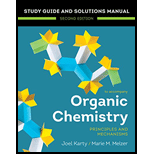
Concept explainers
Interpretation:
Free energy diagrams for the carbocation rearrangements shown in Equations 8-40 and 8-41 are to be drawn.
Concept introduction:
Carbocations are charged, high energy species. They are reactive species as a result of the high energy. They are also subject to rearrangements, particularly if it results in an alternate structure of lower energy. The carbocation may be stabilized by hyperconjugation or by resonance delocalization of the charge. The stability of a carbocation increases in the order
Another way in which a carbocation can reduce its energy is through resonance; this delocalizes the charge on more than one atom.
Want to see the full answer?
Check out a sample textbook solution
Chapter 8 Solutions
Organic Chemistry: Principles And Mechanisms: Study Guide/solutions Manual (second)
- 6. Provide the products for the reactions. Take note of the changes and how they tie together for the overall result. Br H20 NANH2 З еq Br Br NaNH2 2 eq Br 1. NANH2, 3 eq 2. Hао Br2 1. NaNH2, 3 eq 2. H2O OH conc. H2SO4 Br2 heatarrow_forward4-42 For each alkane, 1. Draw all the possible monochlorinated derivatives. 2. Determine whether free-radical chlorination would be a good way to make any of these monochlorinated derivatives. (Will the reaction give mostly one major product?) 3. Which monobrominated derivatives could you form in good yield by free-radical bromination? (a) cyclopentane (c) 2-methylpentane (b) methylcyclopentane (d) 2,2,3,3-tetramethylbutanearrow_forwardThe solvolysis of 2-bromo-3-methylbutane potentially can give several products, includingboth E1 and SN1 products from both the unrearranged carbocation and the rearrangedcarbocation. Mechanisms 6-6 (page 282) and 7-2 (previous page) show the products fromthe rearranged carbocation. Summarize all the possible products, showing which carbocationthey come from and whether they are the products of E1 or SN1 reactions.arrow_forward
- 4. Explain why one of the carbocations below is much more stable than the other. Illustrate with an appropriate orbital overlap picture. stable unstablearrow_forwardMatch the species with the description of its reactivity. alkene chloride 1. nucleophile carbocation 2. electrophile HCIarrow_forwardDraw the major organic product of the reaction shown below. OH lan 8 [References] K₂Cr₂O7 H₂SO4, H₂O You do not have to consider stereochemistry. • You do not have to explicitly draw H atoms. In cases where there is more than one answer, just draw one. SALL ? ChomDoodlo ?arrow_forward
- 2. In the hydroboration/oxidation of the alkene below, two diastereomers are possible. Circle the one that would be the major product. 1. B₂H6 2. NaOH, H₂O₂ HO HO amani 2arrow_forwardCurved arrows are used to illustrate the flow of electrons. Using the provided starting and product structures, draw the curved electron- pushing arrows for the following reaction or mechanistic step(s). Be sure to account for all bond-breaking and bond-making steps. H3C H Na Ⓒ H3C, HH 'H NH₂ Drawing Arrows heat Hege H3C CH3I NaOH, H₂O ix :I: Ⓒarrow_forwardCurved arrows are used to illustrate the flow of electrons. Using the provided starting and product structures, draw the curved electron-pushing arrows for the first step of this reaction sequence. Be sure to account for all bond-breaking and bond- making steps. I H BH₂ H B H Select to Add Arrows > H Bll H BH₂arrow_forward
- 3. Review free radical addition of HX to alkenes. Draw the favored product in each reaction below. Which reaction is faster? Justify your answer. H₂N HO HCI, ROOR HCI, ROORarrow_forwardIdentify the reaction sequence that will make the compound below from benzene. & 01. Br 0 CIN, AICI3 2. Br2, FeBr3 01. Br₂, FeBr3 2. ai AICI 3 , AICI 3 2. Zn(Hg), HCI 3. Br2, FeBr3 i AICI3 2. Br₂, FeBrs 3. Zn(Hg), HCIarrow_forwardFigine 8-6 Br 애 애arrow_forward
 Organic Chemistry: A Guided InquiryChemistryISBN:9780618974122Author:Andrei StraumanisPublisher:Cengage Learning
Organic Chemistry: A Guided InquiryChemistryISBN:9780618974122Author:Andrei StraumanisPublisher:Cengage Learning
